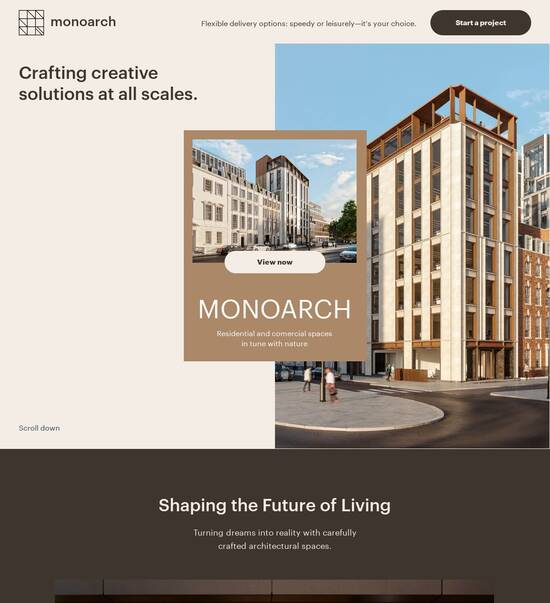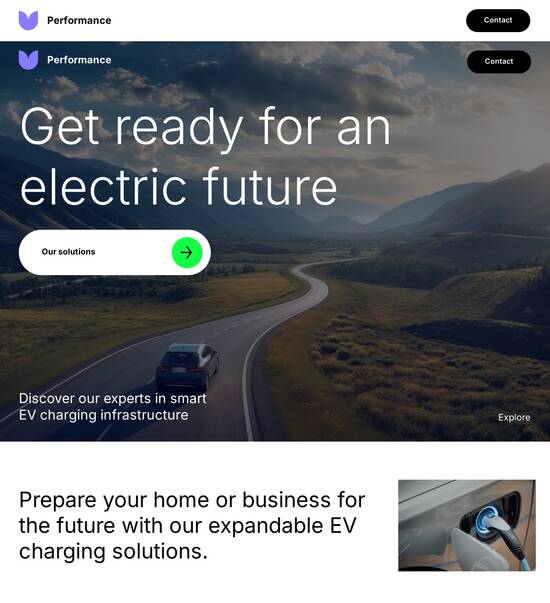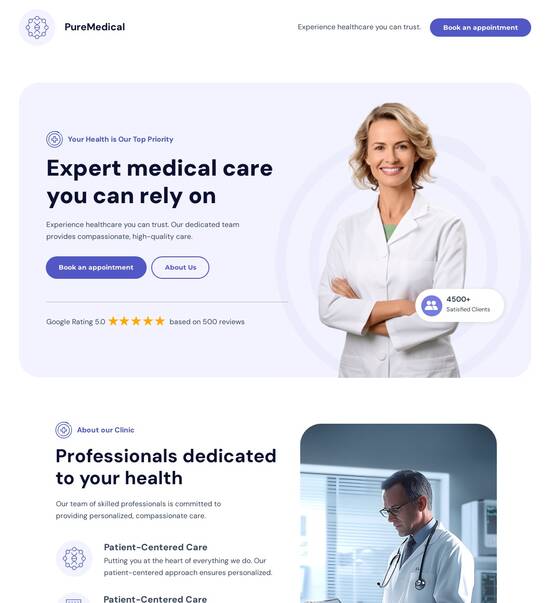
React.js optimized feedback page template
Explore Similar TemplatesAbout template
Supercharge your feedback page with React.js for outstanding performance! Learn more today.
Recommended templates

Easy to build without coding
With the intuitive drag-and-drop builder, anyone on your team can create high-converting pages without any knowledge of code or design. Make enhancements to your landing page with custom widgets using Javascript, HTML/CSS, or third-party scripts.

Multiple layouts for any industry and goal
Select from 500+ landing page layouts built to boost conversions across industry-specific scenarios. Customize them by adjusting fonts, adding images, and generating on-brand content with the AI assistant. Quickly scale with Instablocks® and Global Blocks that you can save, reuse, and update globally.

Loads fast and looks polished on any device
Every template is responsive, which means they present professionally on any device and load blazingly fast with our Thor Render Engine. You can also power them up with Google AMP technology to deliver an unparalleled mobile experience and drive higher conversions.

Robust analytics & experimentation
Get real-time updates and reporting across all your devices, showing the number of visitors, conversions, cost-per-visitor, and cost-per-lead. Launch AI-powered experiments, run A/B tests, and use heatmaps to analyze user behavior, then optimize your landing page to maximize conversions.







Easy to build without coding
With the intuitive drag-and-drop builder, anyone on your team can create high-converting pages without any knowledge of code or design. Make enhancements to your landing page with custom widgets using Javascript, HTML/CSS, or third-party scripts.
Multiple layouts for any industry and goal
Select from 500+ landing page layouts built to boost conversions across industry-specific scenarios. Customize them by adjusting fonts, adding images, and generating on-brand content with the AI assistant. Quickly scale with Instablocks® and Global Blocks that you can save, reuse, and update globally.
Loads fast and looks polished on any device
Every template is responsive, which means they present professionally on any device and load blazingly fast with our Thor Render Engine.
Robust analytics & experimentation
Get real-time updates and reporting across all your devices, showing the number of visitors, conversions, cost-per-visitor, and cost-per-lead. Launch AI-powered experiments, run A/B tests, and use heatmaps to analyze user behavior, then optimize your landing page to maximize conversions.
All the features you need to build lead-generating landing pages
Explore more featuresLearn how to build top-performing landing pages for any goal
FAQs
Leading the way in building high-performing landing pages





Transform Your Marketing with Instapage's Landing Page Solutions
Instapage is the ultimate solution for marketers looking to enhance their digital marketing campaigns through the power of optimized landing pages. With its robust platform tailored specifically for diverse industries like tech and financial services, Instapage provides the necessary tools to accelerate conversions and maximize ROI effectively. Whether you're part of a large enterprise or a small business, Instapage's landing page optimization capabilities allow you to capture leads and drive results seamlessly.
Why Choose Instapage for Your Marketing Needs?
Instapage stands out due to its holistic approach to landing page creation and conversion rate optimization (CRO). From intuitive page builders to analytics dashboards, every feature is designed with your success in mind.
- Access to over 100 ready-to-use templates ensures quick and effective page creation tailored to your audience's needs.
- Built-in A/B testing and heatmaps allow marketers to optimize their campaigns based on real user behavior data.
- Collaboration tools facilitate efficient teamwork, enabling real-time edits and instant feedback from stakeholders.
Step 1: Selecting the Right Template
The first step in enhancing your marketing strategy with Instapage is to choose the right landing page template that resonates with your target audience. A well-crafted template can be the difference between a visitor and a lead.
- Review industry-specific templates designed for sectors like education or financial services to ensure targeted messaging.
- Utilize high-converting layouts that have been tested and proven to drive results for businesses similar to yours.
- Customize templates for unique ad campaigns to improve alignment and consistency across channels.
Step 2: Optimize for Performance
After selecting your template, it's crucial to optimize your landing pages for higher conversions. Take advantage of Instapage's built-in tools to ensure your pages resonate with visitors.
- Conduct A/B tests to determine which headlines, images, and calls-to-action perform best with your audience.
- Utilize detailed analytics to track user interactions and identify areas for improvement.
- Apply dynamic text replacement to tailor content specifically for different audience segments, optimizing personalization.
Step 3: Launch and Collaborate
Finally, once your pages are optimized, it's time to launch! Leveraging collaboration tools allows for a smoother review process, ensuring all feedback is quickly addressed.
- Share pages securely with stakeholders for input and approval, streamlining the revision process.
- Conduct real-time edits to adapt your marketing strategies promptly as needed.
- Utilize collaboration features to enhance creativity and input from different team members.
With these steps, you can transform your marketing approach, turning prospects into customers with exceptional landing pages. Instapage’s powerful tools give you the edge you need in a competitive digital landscape.
Ready to elevate your marketing campaigns? Sign up for Instapage today to harness the full potential of optimized landing pages tailored for your business.
People also ask about React.js optimized feedback page template
Crafting a dynamic feedback experience: The ReactJS optimized feedback page template
The need for feedback mechanisms in modern web applications
User feedback plays a crucial role in shaping the success of modern web applications. It not only helps developers refine their products but also fosters a stronger connection between users and the application. By actively engaging with user sentiments, businesses can harness valuable insights to improve their offerings. Without such mechanisms, applications may fail to meet the evolving needs of their audience, leading to dissatisfaction and abandonment.
Furthermore, feedback is integral to enhancing user experience through iterative design. Each piece of feedback can serve as a stepping stone for adjustments and enhancements, making the user experience progressively better with each iteration. In agile methodologies, feedback loops are crucial; they allow teams to adapt quickly based on user input, ultimately resulting in a product that is tailored to the user’s needs.
Improves product quality
Enhances user loyalty
Guides development cycles
Understanding ReactJS: A powerful tool for feedback pages
ReactJS emerges as a strong candidate for developing feedback pages, thanks to its component-based architecture. This structure allows developers to break down interfaces into reusable components, optimizing both development efficiency and user interaction. When creating a feedback system, this approach can significantly minimize duplication of effort, ensuring that updates and changes are propagated across various parts of the application seamlessly.
Moreover, ReactJS optimizes performance through its virtual DOM. By efficiently updating only the parts of the UI that change in response to user input or other data updates, ReactJS can provide a fast and responsive experience. This is especially vital in feedback pages where users require instantaneous feedback on their inputs without delays, as any lag can lead to frustration and potentially abandoned submissions.
Core features of the ReactJS optimized feedback page template
One of the main attractions of a ReactJS optimized feedback page template is its dynamic user interface. Thanks to real-time data binding, changes made by the user can be immediately reflected in the UI. This is particularly beneficial in feedback applications, as users can see their responses update in real-time. Furthermore, adhering to responsive design principles ensures that the feedback page remains fully accessible across a multitude of devices, from smartphones to desktops.
A user-friendly input validation system is essential as well. Ensuring that data entered is accurate can be achieved with JavaScript code that validates inputs as they are being typed. For example, implementing basic checks for email formats or required fields can significantly reduce user error and improve data quality. Popular validation techniques include regular expressions for pattern matching and utilizing helper libraries that simplify the process.
Real-time data binding for responsive interaction
Comprehensive user input validation techniques
Standardized Q&A format for structured responses
The approach to building the feedback page template
When embarking on the development of a ReactJS optimized feedback page template, it’s crucial to select the appropriate technological stack. Essential libraries like Redux for state management and Axios for making HTTP requests can streamline the process. Integrating third-party APIs can enhance functionality, such as incorporating AI-driven sentiment analysis on the feedback collected, thereby adding depth to the insights that can be drawn from user input.
Breaking down the application into components is also vital for managing complexity. Typical structures may include forms, buttons, and modals, all designed to encourage user interaction. Managing state effectively within the app will help keep track of user inputs and the current status of the feedback collection process without confusing the user.
Utilizing Redux for state management
Implementing Axios for API calls
Creating reusable components for efficiency
Value-driven design: aligning feedback pages with user needs
To truly resonate with the intended audience, it's essential to understand user communities thoroughly. Tailoring feedback questions to fit the characteristics and expectations of different user groups increases the likelihood of eliciting valuable responses. This also encompasses ensuring inclusivity, adapting questions so they are understandable and accessible to a diverse audience.
Features that encourage participation can significantly boost user engagement. Introducing gamification elements, such as rewards or points for providing feedback, can motivate users to engage more actively. Additionally, ensuring that the feedback collection process is accessible and considers varying user capabilities helps to foster a sense of belonging and encourages contributions.
Tailored feedback questions for specific user segments
Incentives and rewards to motivate user feedback
Accessibility features for diverse user needs
Exploring the information flow: collecting and analyzing feedback
There are various techniques for collecting feedback, each with its pros and cons. For instance, surveys typically provide structured responses that are easy to analyze, whereas open-ended questions might yield richer qualitative insights but can be more challenging to interpret. Presenting real-time previews of user inputs during the feedback process can greatly enhance user experience by offering immediate confirmation of their inputs.
Once feedback is collected, innovative methods for analyzing the data can reveal patterns and opportunities for improvement. Utilizing data visualization techniques, such as charts and graphs, can make the insights more digestible and actionable. Furthermore, categorizing feedback is important for organizing responses in a way that prioritizes actionable insights through analysis.
Surveys for structured data and easy analysis
Open-ended questions for deeper insights
Visualization techniques for data interpretation
The role of teams in feedback page development
Collaboration across disciplines is key to successful feedback page development. Involving designers, developers, and stakeholders in the process ensures that the final product aligns with user needs while maintaining technical feasibility. Regular feedback loops within teams also help identify potential issues early and facilitate constant improvement throughout the building process.
Knowledge sharing within teams is equally important. Hosting workshops or knowledge-sharing sessions can help bring everyone up to speed with the latest ReactJS advancements and best practices. Engaging with external ReactJS communities can also provide invaluable insights and broaden perspectives about user engagement strategies.
Cross-discipline collaboration for better outcomes
Workshops and community engagement for skill enhancement
Regular feedback loops for continuous improvement
Leveraging location and context for tailored user experiences
Utilizing geolocation data can provide a powerful means to customize the user feedback experience. Based on a user’s location, feedback forms can be adjusted to include relevant options or questions that reflect local nuances or preferences. This not only enhances the relevance of the questions but also conveys to users that their opinions are valued and pertinent to their context.
Moreover, providing contextual feedback prompts at optimal times can significantly improve response rates. By timing feedback requests such as post-purchase or after a specific interaction, developers can ensure that the prompts are as relevant and engaging as possible. Delivering context-aware feedback forms that align with the user’s journey results in more thoughtful and constructive input.
Geolocation inputs for targeted question tailoring
Contextual prompts following user interactions
Enhancing relevance to improve response quality
Maximizing the benefits of a feedback page template
Measuring the impact of the feedback page involves identifying key performance indicators (KPIs) that align with business objectives. Indicators such as response rates, completion rates, and user satisfaction scores can provide insights into the effectiveness of the feedback collection process. Balancing quantitative and qualitative data will ensure a comprehensive understanding of user engagement.
Using feedback for continuous improvement should be a priority. Implementing iterative design cycles based on analysis of user insights can lead to enhancements in product features, improving user satisfaction in the long term. Ultimately, a well-developed feedback page that incorporates user input effectively can foster sustainable growth and innovation in products.
Identifying KPIs to track success
Ensuring balance between quantitative and qualitative insights
Iterative designs based on user input
Future trends in feedback page development
Emerging technologies like artificial intelligence (AI) and machine learning (ML) are beginning to play a pivotal role in feedback analysis. These technologies can assist developers in identifying patterns within the feedback data, leading to predictive analytics that can forecast user behavior and preferences. Such advancements pave the way for more intelligent and responsive feedback systems.
Furthermore, the evolution of user engagement is pushing towards non-intrusive feedback mechanisms. The ideal future of feedback collection is user-driven, where users feel encouraged rather than pressured to provide insights. Envisioning the next generation of feedback tools, ReactJS holds immense potential to create more adaptive and user-friendly experiences.
AI and ML for deeper insights and predictive analytics
Shifting towards non-intrusive feedback mechanisms
Innovative tools for adaptive feedback experiences
Common questions and misconceptions
Addressing frequently asked questions helps clarify essential aspects of feedback page development. For instance, many wonder about the security of user feedback data. Implementing robust encryption and data protection measures ensures that user information remains confidential. Another common query relates to the average response rate for feedback forms. Typically, rates can vary significantly based on the industry and method of collection, but engagement strategies, such as follow-ups and incentives, can markedly improve results.
Additionally, it’s important to dispel myths surrounding user reluctance to provide feedback. Many users appreciate the chance to voice their opinions when done in a supportive environment. Another misconception revolves around balancing usability and functionality. By investing in thoughtful design processes, developers can achieve both, creating an intuitive interface that maintains rich functionality.
Understanding data security and protection measures
Exploring industry-specific response rate averages
Clarifying usability vs. functionality balance
Creating a community around feedback
Building collectives for ongoing support can significantly enhance the feedback process. Establishing online forums allows users to discuss their experiences and share their insights with each other. Encouraging peer-to-peer support within these communities can foster a sense of belonging and motivate more users to engage in feedback collection.
Promoting shared values of improvement is essential for cultivating a culture that values and acts on feedback. This can be achieved by consistently communicating to users how their feedback has influenced decision-making, thereby fostering trust and encouraging ongoing participation. Creating environment where users feel heard and valued leads to a thriving culture of user-driven innovation.
Establishing online forums for discussion
Encouraging peer-to-peer support within communities
Cultivating a culture of trust and user-driven innovation
Ready to skyrocket conversions?
Supercharge your ad campaigns with high-performing landing pages
Get started














